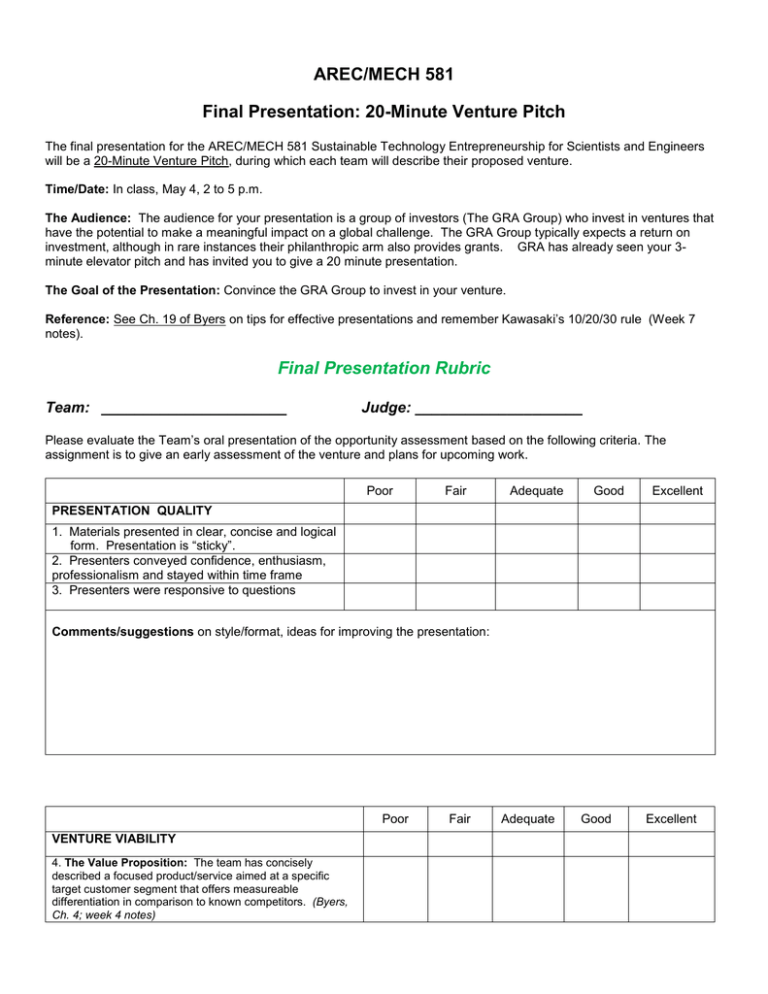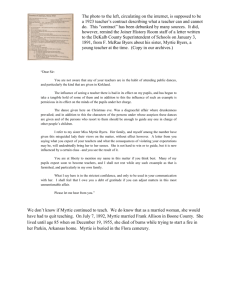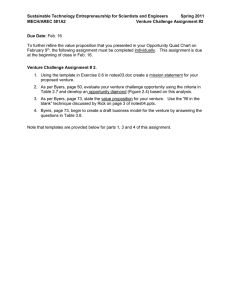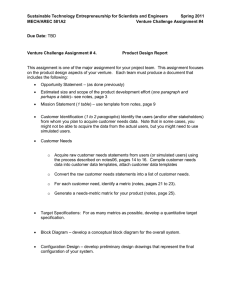final-pres.doc
advertisement

AREC/MECH 581 Final Presentation: 20-Minute Venture Pitch The final presentation for the AREC/MECH 581 Sustainable Technology Entrepreneurship for Scientists and Engineers will be a 20-Minute Venture Pitch, during which each team will describe their proposed venture. Time/Date: In class, May 4, 2 to 5 p.m. The Audience: The audience for your presentation is a group of investors (The GRA Group) who invest in ventures that have the potential to make a meaningful impact on a global challenge. The GRA Group typically expects a return on investment, although in rare instances their philanthropic arm also provides grants. GRA has already seen your 3minute elevator pitch and has invited you to give a 20 minute presentation. The Goal of the Presentation: Convince the GRA Group to invest in your venture. Reference: See Ch. 19 of Byers on tips for effective presentations and remember Kawasaki’s 10/20/30 rule (Week 7 notes). Final Presentation Rubric Team: ______________________ Judge: ____________________ Please evaluate the Team’s oral presentation of the opportunity assessment based on the following criteria. The assignment is to give an early assessment of the venture and plans for upcoming work. Poor Fair Adequate Good Excellent PRESENTATION QUALITY 1. Materials presented in clear, concise and logical form. Presentation is “sticky”. 2. Presenters conveyed confidence, enthusiasm, professionalism and stayed within time frame 3. Presenters were responsive to questions Comments/suggestions on style/format, ideas for improving the presentation: Poor VENTURE VIABILITY 4. The Value Proposition: The team has concisely described a focused product/service aimed at a specific target customer segment that offers measureable differentiation in comparison to known competitors. (Byers, Ch. 4; week 4 notes) Fair Adequate Good Excellent 5. Business Model: The team has proposed a business model that will achieves significant impact, be sustainable and appears to be scalable. (Byers, Ch. 7; week 6 & 7 notes- Business Model Canvas and 3x5) 6. Market Opportunity: The team has identified a significant market need and an initial plan to take advantage of that need; market research supports the opportunity and a specific target market has been identified (Byers, Ch. 11; week 13 notes) 7. Competitive Advantage: The team has described competitive products/services and has articulated a competitive advantage for their product/service relative to other competing products/services pursuing the identified market opportunity. (Byers, Ch. 5; week 4 and 5 notes) 8. Customer Needs: The team has adequately identified the target customers, acquired customer needs data and compiled the data into a list of customer needs for their product or process. (Ulrich, Ch. 4; Week 6 notes) 9. Target Specifications: The team has translated the customer needs into a list of target specifications (metric and value). (Ulrich, Ch. 5; Week 8 notes) 10. Proposed design of product of service. The team has evaluated multiple conceptual designs (or process/service models) and chosen the “best” final configuration design (or service) to take to market. (Week 8 notes). 12. Legal Formation and Founding Team. The team has chosen the appropriate corporate structure and has a plan in place to address deficiencies in expertise in the founding team (i.e. through board of advisors or board of directors) (Byers, Ch. 10 and Ch. 12) 11. IP/Regulatory Strategies: The team has considered the main opportunities and challenges they face in the regulatory and intellectual property environments. (Byers, Ch. 10 and Week 11 notes) 12. Sources of Capital: The team understands the differences between different sources of capital and has described a plan to attract the financial resources necessary to bring the product to market. (Byers, Ch. 18 and Week 12 notes). 13. Project Plan & Budget: The team has provided an overview of the activities and required budget for moving from concept to product launch; the team has adequately recognized the size and scope of the product development effort necessary to bring the product to market. (Byers, Ch. 2, Ch.3 and Ch. 7; Week 3 and 7 notes). 14. BOTTOM LINE: The team has proposed a design and a venture that could make a meaningful impact on an important challenge. Comments/suggestions on content and ideas for pursuing the venture:



